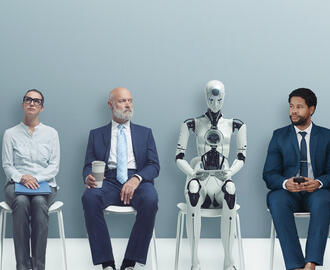Credit: Shutterstock / VectorMine
If you’re a business leader, you’d be remiss if you hadn’t at least explored how artificial intelligence, robotics, and automation can increase efficiency, productivity, and profitability for your company.
Now, a new report from MIT is asking the private sector — alongside policymakers, labor organizations, and educational institutions — to consider with equal seriousness how these technologies will affect the American workforce. The goal: “To generate greater economic security for workers, higher productivity for firms, and broader opportunity for all members of society.”
In response to widespread societal anxiety and pessimism over the prospect of AI and robotics displacing millions of workers, MIT last year commissioned the Task Force on the Work of the Future to examine closely how new technologies are altering skill demand and job opportunities, and to explore strategies for a future of shared prosperity.
Co-chaired by MIT professors David Autor and David Mindell, with Elisabeth Reynolds as executive director, the task force found pessimism over the advent of smart technologies was neither “misguided nor uninformed.” Unlike other eras of intense technological advancement, the report says, this time there is no guarantee that increased economic output will reach the typical worker.
What’s different this time
Over the past two centuries, innovation has been in a constant cycle of transforming work, from the arrival of the internal combustion engine, electricity, telecommunications, and on.
Each time, painful labor market adjustments — for example, the loss of specific skill sets like weaving or typesetting or whole occupations such as blacksmiths and switchboard operators — were offset by gains in productivity and earnings, alongside safer working conditions, reduced work hours, and opportunities for more creative employment.
So why are workers pessimistic and anxious now, when the industrialized world is undergoing rapid employment growth? A 2018 survey by the Pew Research Center found that most people believe automation will “greatly exacerbate inequality between rich and poor while making jobs harder to find,” the report states. Less than one third of those surveyed believe that new, better-paying jobs will emerge.
That public pessimism may reflect the hard-learned lessons of recent history, the report acknowledges. Research by Autor found that earnings growth in the past 40 years has been “slow, sporadic, and unequal,” with earnings rising robustly for adults with college and post-college degrees, but lagging for other sectors.
Among men without college degrees working full time, real weekly earnings in 2018 were actually 10% to 20% below their levels in 1980, nearly four decades earlier, the report states. Further, for the typical worker, productivity growth no longer automatically translates into wage growth. After about 1973, labor productivity rose by 75%, yet the compensation of workers rose by only 12%, with gains distributed unevenly toward the most-educated workers.
Technology isn’t the only reason for this gap — international trade and a fall-off of union activity contributed as well — but computers and the internet enabled a digitization of work that made highly educated workers more productive and less educated workers “easier to replace with machinery,” the report reads.
Now, as society stands on the cusp of a “technological revolution” in artificial intelligence and robotics, leaders from a variety of disciplines can and should take action to improve middle-skill jobs while these technologies are still in their early stages, the report authors argue.
A checklist for business
Education, public policy, and labor relations will play a central role in ensuring greater economic security for workers and higher productivity for firms, the report states. But business has an active role to play.
Specifically, business leaders should:
Make better use of work-based learning programs like co-ops, apprenticeships, and “sectoral employment programs,” which, like apprenticeships, offer on-the-job training but don’t require the creation of formal or registered apprenticeship positions.
John Kelly, chief technology officer of IBM, who spoke at a Washington, D.C. panel announcing the report, said that businesses can combine technology with these types of training to develop quality jobs that don’t require a four-year degree.
“We have a program, Pathways to Technology, in 200 or so schools, and we have found that in a sense we've over-spec’d some of these jobs,” Kelly said. “If I take a cyber security analyst in an operations center, we've traditionally said you have to have a four-year degree. Not true. If we take a two-year degree person and give them AI tools and training, they can hit the ground running and often surpass people with higher-level degrees.”
Avoid ‘so-so’ technologies that displace workers without improving customer experience or boosting productivity. As identified by MIT Sloan economists Daron Acemoglu and Pascual Restrepo, so-so technologies include computerized telephone agents deployed by airlines and hotels, and self-checkout kiosks offered by large retailers. “Both technologies perform tasks previously done by workers, yet neither improves the quality of the product or service,” the report points out.
That point hit home with Kelly. “Sometimes when you put technology in, it may improve productivity, but it doesn't improve the overall solution and value,” he said. “We're finding that with AI. You just can't throw it in, plug it in, turn it on, and it works. You've got to adapt the technology for the process; otherwise, all you do is automate something which was lousy, and you going to get a lousy result.”
Seek out and implement advances that complement the skills or workers, or free them up for higher-value work. Commercial robots can take on mundane human tasks such as stocking, transporting, and cleaning, while machine learning can help radiologists better interpret X-rays or assist paralegals with document discovery.
In rolling out these technologies, business leaders must be prepared to adjust work systems and management practices.
Recognize workers as stakeholders, and experiment with new forms of worker representation beyond the traditional trade union model.
Elizabeth Shuler, secretary-treasurer of the AFL-CIO, who also spoke at the Washington panel, said the labor workforce is particularly susceptible to so-so technologies, which could be made better and more productive with input from the people who will actually implement them.
In cases where technology stands to directly replace workers — as in mobile check-in and robotic cleaning services in the hospitality industry — employees should be given notice, transition assistance, and reskilling options well in advance, one provision Marriott workers were demanding in their recent strike.
“Technology was one of the top three reasons why they went on strike,” Shuler said. “They said, ‘We think we need to have a seat at the table as technology is introduced in the workplace.’”





